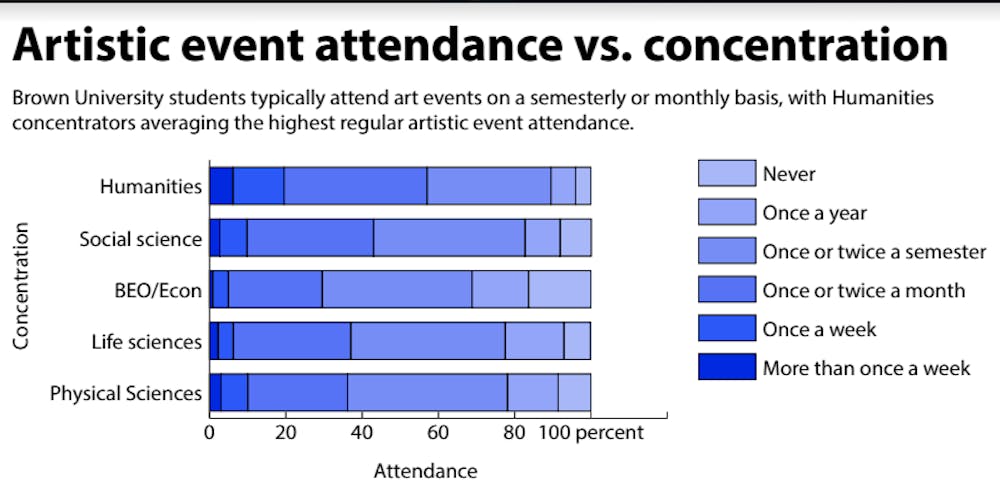With students’ eyes focused on the performers on stage, the audience is sometimes forgotten.
The Herald’s spring 2016 poll found that those who attend arts events most frequently tend to be non-first-generation students and mostly white students.
“I think that a lot more needs to be done by way of outreach or inclusion,” said Zach Silberberg ’18, a member of IMPROVidence, an improvisational comedy group, and a Herald illustrator.
According to poll results, 11.5 percent of first-generation students have never been to an arts event, compared to 7.3 percent of non-first-generation students. About half of white students attend arts events at least once a month, whereas about 40 percent of students of color attend with the same frequency.
More and more, cost and accessibility has become less of an issue, said Yolanda Rome, associate dean for first-year and sophomore studies. Many arts organizations have made a concerted effort to eliminate these boundaries.
“We’ve found ways to get tickets to low-income and first-gen students,” said Patricia Ybarra, chair of theatre arts and performance studies. Production Workshop and Musical Forum do not charge for performances, and Sock and Buskin has launched initiatives to get tickets to first-generation students.
Part of the discrepancy could have to do with the fact that much of the appeal of arts events is attending with friends, Rome said. Often, first-generation students tend to “seek each other out, so they can understand and talk about their experience with other people who share their perspective,” she added. When first-generation students do not see their friends attending arts events, they might not go either.
Valentin Perez ’18 speculated that the disparity had to do with the way the materials were advertised or worded.
“Making sure that the people represented in the pictures are diverse, from different races and socioeconomic classes — it lets them know that it’s something that people like them (would want to) go to,” he said.
Still, while 10 percent of white students reported attending arts events once a week, only 5 percent of students of color reported attending arts events as often.
In light of this discrepancy, some groups have made strides to increase diversity within their groups.
“I’m so proud of our group right now because in regards to gender and to race, over the last two years we have brought in amazingly talented and funny people that are not just white men, and this is reflected in the audience,” Silberberg said.
Benjamin Hayslett-Ubell ’18.5, a member of Out of Bounds Sketch Comedy, echoed this sentiment. “Now there is a more conscious effort to make the space more inclusive,” he said.
In March, The Herald wrote about how those from diverse backgrounds navigate the comedy space at Brown.
“The sorts of conversations about how gender and race and class have influence even on a group of friends are conversations happening,” Hayslett-Ubell said. “They’re really hard sometimes, but these conversations must take place.”
Hayslett-Ubell and Silberberg noted that often those attending events reflect the demographics of the performers. “We’re inviting the people in our friend groups,” Silberberg said. “And when there are these same circles, it’s going to end up being the same people.”
In the same vein, Silberberg said: “You’re going to see a lot of the same people going to the same events. This is something that can and should change. … We publicize events on Facebook, (and use) posters — but for the most part, this needs to be better.”
The content of arts events might also shape their audiences.
“A variety of topics would be interesting — beyond the usual Broadway, Eurocentric topics,” said Samanee Mahbub ’19.
For many arts groups, creating a platform for people of color has become an important goal, Ybarra said. By diversifying content, arts groups have attempted to make their events more visibly accessible.
“Last year, we produced a number of shows written by playwrights of color (and) often directed by directors of color. One of the reasons people go to arts events is to see their stories on stage and commitment to telling stories from a diversity of perspectives diversifies your audience,” Ybarra added.
Last year’s production of “In the Heights” drew in an overwhelming response from the Latinx community and beyond, she noted. The sold-out show stands as a testament to the progress in diversifying the arts across campus, she said.
“Even if the arts community and the comedy scene is diversifying naturally, there always needs to be a conscious effort to say that this should not just be a space for white people,” Silberberg said.





